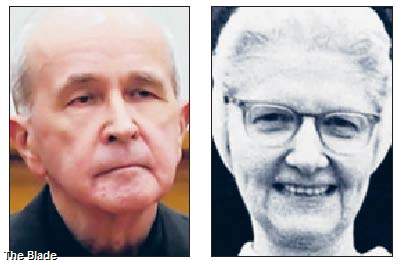Material Is Not from Source Suggested by Defense
By David Yonke
Toledo Blade
July 16, 2009
http://toledoblade.com/apps/pbcs.dll/article?AID=/20090716/NEWS02/907160313/0/COLUMNIST26
New tests of male DNA found on the fingernails of slain Sister Margaret Ann Pahl show that it was not from the Rev. Jerome Swiatecki, the Ohio Innocence Project said.
The results are a setback for Gerald Robinson, the Toledo Catholic priest convicted in 2006 of the nun's 1980 murder, and his defense attorneys who argue that Father Swiatecki may have been the killer.
 |
| The Rev. Gerald Robinson, convicted of killing Sister Margaret Ann Pahl, is being held at the Hocking Correctional Facility. |
"Father Jerome Swiatecki was mentioned as a possible alternate suspect, but he does not match the male DNA found on the victim's body," said Karla Markley Hall of the Ohio Innocence Project, a nonprofit legal clinic based at the University of Cincinnati.
Previous tests had determined that the DNA found on the nun's fingernails was not Robinson's.
Dean Mandros, chief of the criminal division of the Lucas County prosecutor's office, said that "we are not at all surprised at this result. We proved in court who Sister Pahl's killer was, and the defendant is welcome to spend all the money he wants doing additional DNA testing because it won't change anything."
The Ohio Innocence Project's next step is to test the DNA of Coral Eugene Watts, an infamous serial killer who lived in the Detroit area around the time of Sister Margaret Ann's murder, Ms. Hall said.
Father Swiatecki, who died in 1996 at age 82, was serving as a chaplain along with Robinson at the former Mercy Hospital when Sister Margaret Ann was murdered on Holy Saturday, 1980.
Robinson's attorneys say the wrong priest was convicted and plan to press their case despite the latest DNA findings.
"If the DNA established that Swiatecki did it, then it shortcuts a lot for us. But the absence of evidence doesn't prove anything," Rick Kerger, one of Robinson's defense attorneys, said.
Watts, who died in a Michigan prison in 2007 at age 53, was never considered a serious suspect in Sister Margaret Ann's murder, according to prosecutors.
He confessed to killing a dozen women in Texas and is suspected in as many as 80 murders in several states, according to the Michigan attorney general's office.
The Lucas County prosecutor's office obtained a sample of Watts' DNA from Michigan law enforcement officials on condition that the Ohio Innocence Project pay for testing, which costs about $1,500 per procedure.
Sister Margaret Ann was killed on April 5, 1980, the day before Easter and the day before her 72nd birthday. The victim was grabbed from behind, choked nearly to death, and then stabbed 31 times in the chest, neck, and face.
She was found dead with her clothes disheveled on the floor of the sacristy next door to the chapel of Mercy Hospital - now Mercy College of Northwest Ohio - near downtown Toledo.
Robinson was arrested 24 years later and found guilty of murder in Lucas County Common Pleas Court on May 11, 2006.
The 71-year-old priest, who has not been laicized, is serving a 15-years-to-life sentence at Hocking Correctional Facility in southern Ohio.
The Ohio 6th District Court of Appeals upheld Robinson's conviction in July, 2008, and the Ohio Supreme Court in December declined to review the case.
John Donahue, a Perrysburg attorney representing Robinson, has appealed to the U.S. Supreme Court and filed an amended petition for post-conviction relief in Common Pleas Court.
Unlike many cold-case trials, Robinson's 2006 conviction hinged more on circumstantial evidence than DNA, which was not used as a forensic tool until a British trial in 1987.
Prosecutors built their case against the priest on evidence involving the murder weapon, the victim's wounds, blood patterns, testimonies, and inconsistencies in Robinson's statements.
The Ohio Innocence Project compared Father Swiatecki's DNA sample - provided by a hospital from a tissue sample used for a biopsy prior to his death - to the male DNA found on fingernail clippings from Sister Margaret Ann's corpse.
The nun's 10 individual nail clippings had been placed together in a solution, dissolved, and then tested for DNA, making it impossible to determine if the male DNA had been on the top, sides, or beneath the victim's nails.
Assistant Lucas County Prosecutor J. Christopher Anderson said the amount of DNA on her fingernails was 37 picograms, or 37 trillionths of a gram - "a very, very tiny amount."
He said the coroner's office in 1980 used scissors to clip the nails and did not sanitize the scissors between uses. The DNA could have come from the scissors, someone touching her hand, or someone coughing or sneezing in the room, he said.
Mr. Anderson said the prosecutor's office performed DNA tests on 54 people before Robinson's 2006 trial and was unable to find a match with the crime scene evidence.
Contact David Yonke at: dyonke@theblade.com or 419-724-7154.
Any original material on these pages is copyright © BishopAccountability.org 2004. Reproduce freely with attribution.